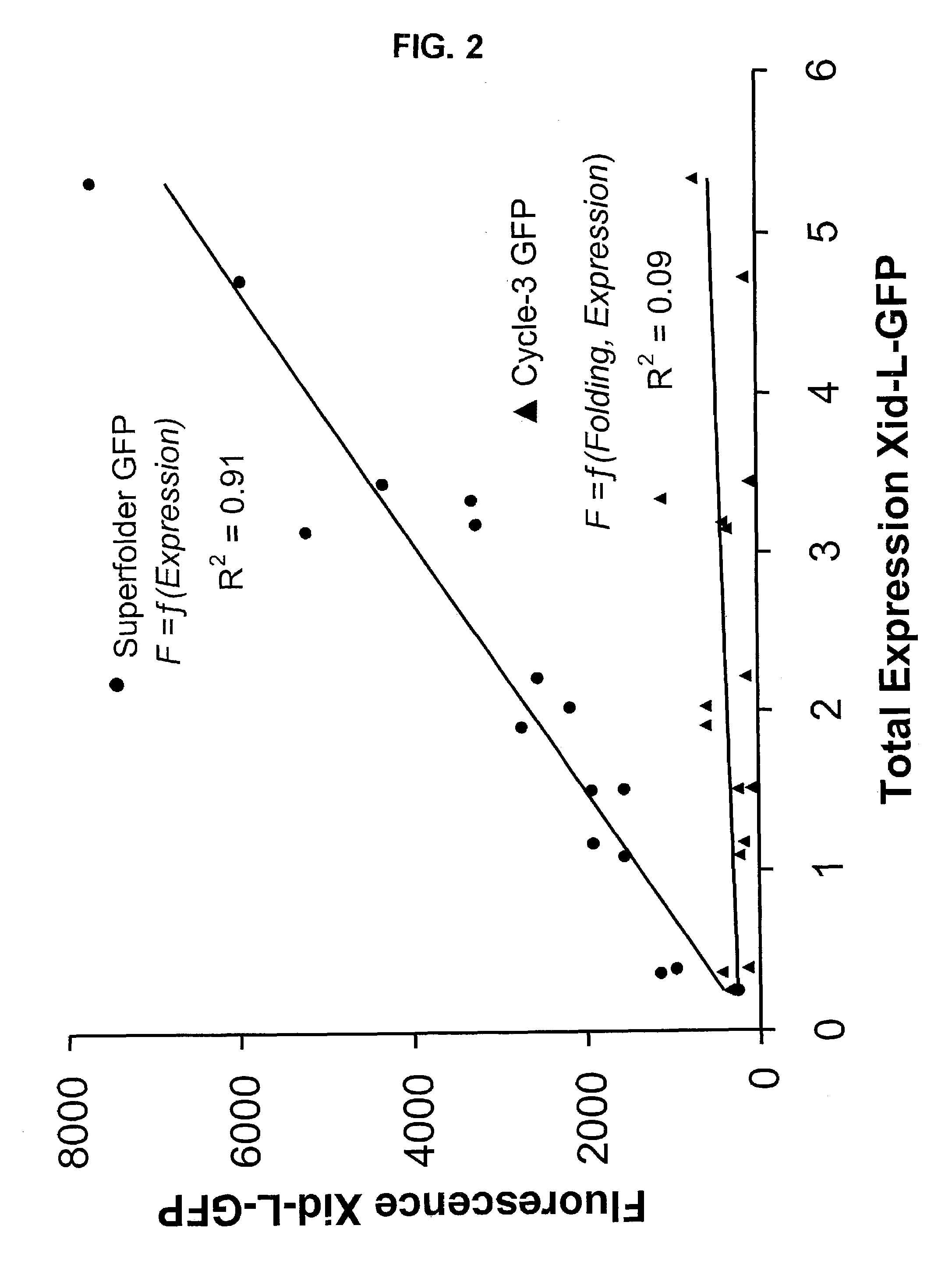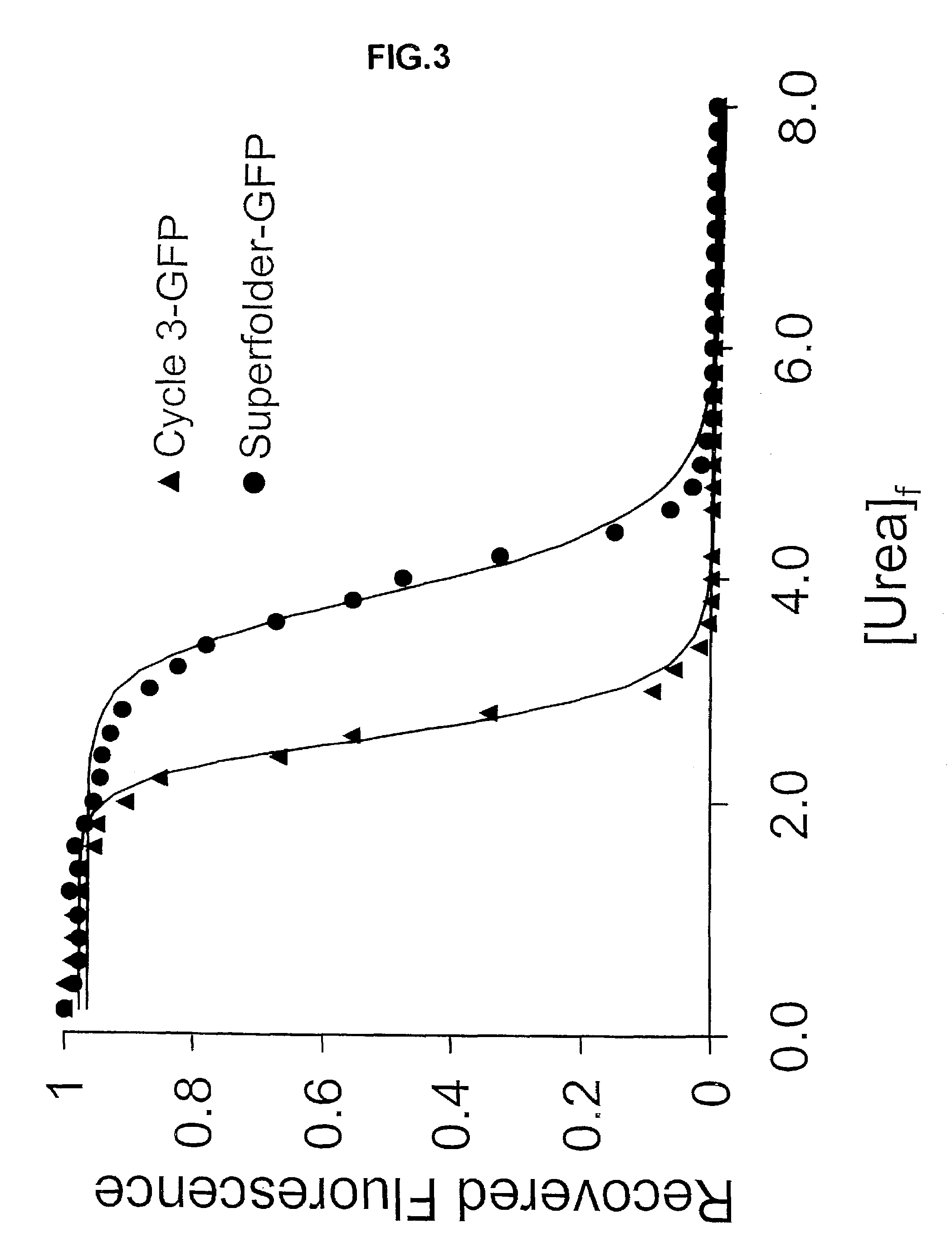Directed evolution methods for improving polypeptide folding and solubility and superfolder fluorescent proteins generated thereby
a technology of superfolder fluorescent proteins and polypeptides, which is applied in the field of directed evolution methods for improving the folding and solubility of polypeptides and the superfolder fluorescent proteins generated thereby, can solve the problems of limiting the progress rate in these areas, no general method for improving intrinsic protein solubility, and many such cloned foreign proteins are insoluble or unstable, so as to improve the solubility and folding characteristics of polypeptides. , the effect of improving
- Summary
- Abstract
- Description
- Claims
- Application Information
AI Technical Summary
Benefits of technology
Problems solved by technology
Method used
Image
Examples
example 1
[0170]The following example describes the use of the method of the invention to generate superfolding variants of GFP.
[0171]To create the ‘superfolder’ GFP variant, a ‘directed evolution’ experiment was performed in which a poorly folded ferritin domain was linked to the sequence of a GFP3 domain (Crameri variant plus F64L and S65T)(Waldo et al., 1999, Nature Biotechnol. 17: 691-695. The ferritin domain provided the ‘bait’ to challenge the GFP3 to fold under stringent conditions.
[0172]After three rounds of in vitro mutation and recombination, followed by in vivo selection, there was no further increase in the brightness of the colonies. Twelve clones were selected and sequenced by fluorescent dye dideoxy-terminator sequencing technology. Most of the clones contained at least 5 of 6 consensus mutations. The consensus mutations were S30R, Y39N, N105T, Y145F, I171V, and A206V. The resulting GFP, termed superfolder GFP (GFPSF), was many-fold brighter as a fusion with ferritin compared t...
example 2
[0175]The following example describes the use of the method of the invention to generate superfolding variants of DsRed.
[0176]To create the evolved superfolder dsRED, we followed the same protocol used to create the superfolder GFP (supra) with the following modifications. The starting material was an improved variant of dsRED with decreased aggregation and increased rate of chromophore formation, termed dsRED T4, previously described by Glick and co-workers (Bevis B J, Glick B S. Rapidly maturing variants of the Discosoma red fluorescent protein (DsRed). Nat Biotechnol. 2002 January;20(1):83-87). The starting variant has the dsRED wild-type sequence, with the indicated mutations of Glick (see Table 1).
[0177]Clone optima were picked from each round of directed evolution as for GFP, except the IllumaTool (Light Tools Research) was equipped with a 580 nm excitation filter, and the plates were either visually examined or photographed, through a 610 nm long pass red filter. After 5 roun...
example 3
Improved GFP Folding due to Superfolder Mutations
[0180]To test the effect of the superfolder mutations in greater detail, 6 single-point mutants of cycle-3 redshift were engineered by PCR using methods well-established in the art. Each mutant incorporated one of the 6 mutations found in the superfolder GFP variant. These were cloned into a pET vector as C-terminal fusions with poorly-folded bullfrog redcell ferritin (Waldo G S, Standish B M, Berendzen J, Terwilliger T C. (1999) Rapid protein-folding assay using green fluorescent protein. Nat. Biotechnol. 17(7): 691-695). Overnight cultures in Luria-Bertani (LB) media containing kanamycin (35 □g.ml−1 were diluted 100-fold and grown for 2 h at 37° C. Proteins were expressed for 4 h by adding isopropyl-□-D-thiogalactopyranoside (IPTG) to 1 mM in 3 ml cultures of LB (Luria-Bertani) media at either 37° C. or 27° C. in E. coli BL21(DE3) as C-terminal fusions with poorly-folded bullfrog red cell H-subunit ferritin. Cycle-3 redshift and sup...
PUM
| Property | Measurement | Unit |
|---|---|---|
| temperatures | aaaaa | aaaaa |
| temperature | aaaaa | aaaaa |
| temperature | aaaaa | aaaaa |
Abstract
Description
Claims
Application Information
 Login to View More
Login to View More - R&D
- Intellectual Property
- Life Sciences
- Materials
- Tech Scout
- Unparalleled Data Quality
- Higher Quality Content
- 60% Fewer Hallucinations
Browse by: Latest US Patents, China's latest patents, Technical Efficacy Thesaurus, Application Domain, Technology Topic, Popular Technical Reports.
© 2025 PatSnap. All rights reserved.Legal|Privacy policy|Modern Slavery Act Transparency Statement|Sitemap|About US| Contact US: help@patsnap.com



